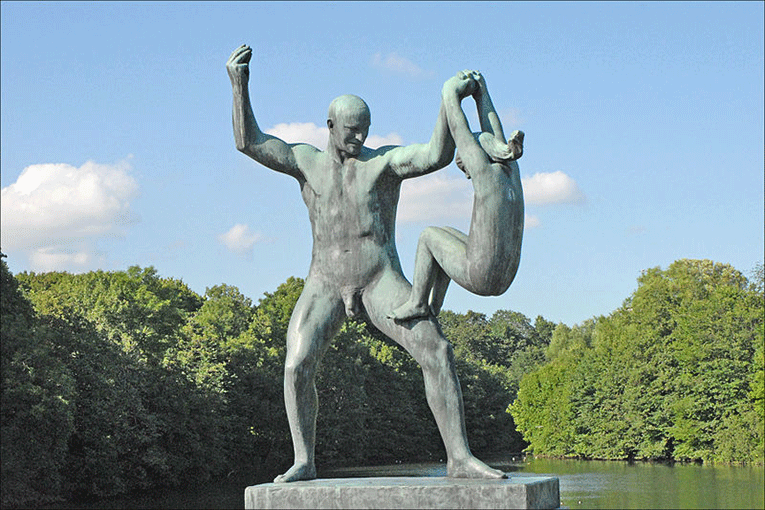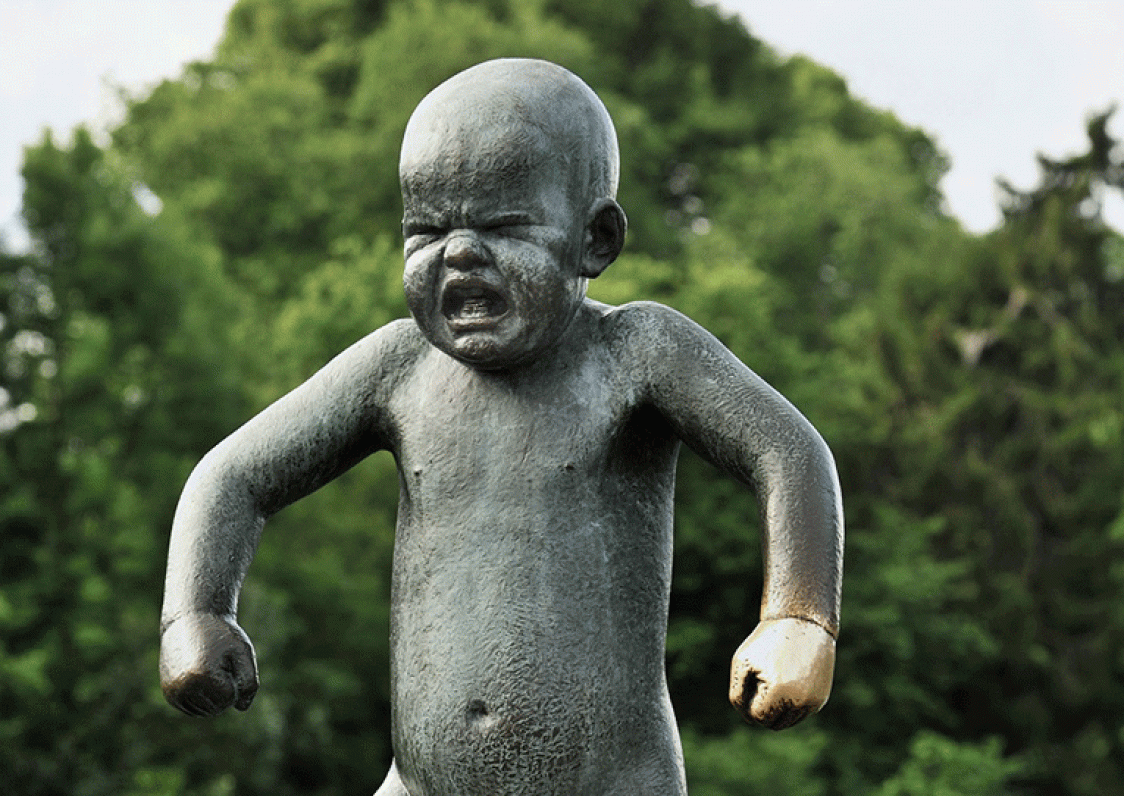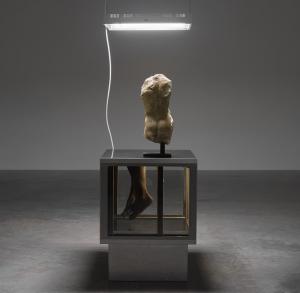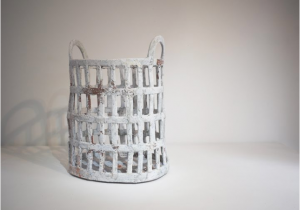THE ANGRY BOY & OTHER STORIES
By Tonje Robertsen
The Vigelands Park in Oslo, Norway, is the result of a unique contract between the sculptor Gustav Vigeland and the City of Oslo. In 1921, the artist agreed to donate all originals of previous and future artistic work to the city, as long as it would provide him with a place to live and work. He soon moved into a grand, red brick building overlooking the Frogner fields and donated the subsequent forty years of his life to the creation of a park quite unlike anything else.
Occupying eighty acres in the western parts of the larger Frogner Park are 212 sculptures made up of over six hundred full-size human figures in bronze and granite. It took the artist forty years to develop the park that tells mesmerising tales of human life from cradle to grave, his figures filled with happiness, grief, frustration, joy and magic. The many sculptures made up by groups of figures display the seemingly old fashioned human feature of empathy.
Amongst the hundreds of sculptures, however, an angry little boy demands most attention. “That’s one angry kid,” I once overheard a tourist exclaim. He does make an impression, Sinnataggen. Following her first sighting of the sculpture, my three year old cousin spent weeks clenching her fists and imitating his expression of utter desperation while attempting to balance on just one of her tiny feet. His name, Sinnataggen, simply means ‘irate child’.
 Vigeland also designed the architectural layout of the park, which today consists of five main sections; the main entrance, the bridge, the fountain, The Monolith plateau and a ‘wheel of life’ in bronze. After walking through the park’s majestic main entrance, large gates of wrought iron and granite, you’ll stroll down a long pedestrian avenue framed by maple trees, before reaching the bridge.
Vigeland also designed the architectural layout of the park, which today consists of five main sections; the main entrance, the bridge, the fountain, The Monolith plateau and a ‘wheel of life’ in bronze. After walking through the park’s majestic main entrance, large gates of wrought iron and granite, you’ll stroll down a long pedestrian avenue framed by maple trees, before reaching the bridge.
The Bridge is a hundred meters long and fifteen meters wide, it’s railings ornamented with lanterns and 58 bronze sculptures. Again, the dominant themes are human relationships; man and woman, old and young. On the other side of the bridge is the Fountain consisting of a large basin carried by six giants, surrounded by twenty bronze tree installations whose trunks are human bodies journeying through the circle of life from the first to the last tree group. The first portrays small children, the last a skeleton resembling a tree trunk in itself, but as the tree groups encircle the fountain they talk of an ongoing process. After death comes life.
The Monolith with its plateau is perhaps the most striking feature of the park, rising 17.3 meters towards the sky. Its 121 figures were all carved out of the same granite block after Vigeland made a full size model of clay in his studio. The granite block, weighing hundreds of tons, was brought to the park by sea from Halden and it took three stone carvers fourteen years to finish The Monolith.
Another 36 figures are placed on its plateau and eight large gates in wrought iron guards the monument. What the artist wanted to say with The Monolith is, to say the least, open to interpretation. The figures seem to be engulfed in both desperation and hope, and ‘togetherness’ has been suggested by some because the figures hold each other up. According to the Vigeland Museum (), however, the artist himself said: “The stone groups tell about life, the column about the world of fantasy. The stone groups can therefore be understood by anyone, each can interpret the column in his own way.”

Like the rest of Norway, the park’s character changes with the seasons. In the winter, thick layers of white snow cover the sculptures and mute all sound. The park becomes a quiet sanctuary, a place for undisturbed meditation allowing visitors a break from the hectic city surrounding it.
During the warm summer months, the park comes alive. The sculptured humans seem ready to break out of their granite and bronze cocoons and join the Osloits who are spreading blankets on the grass after work in order to soak up just a little bit of that healing sunshine they missed out on during a day in the office, desperate to discard the in-house habits of the winter.
Suddenly, they’re swirling through the park on roller blades, jogging in t-shirts with smiles on their faces and meeting friends and colleagues for surreptitious glasses of wine in the public domain of the Frogner Park.
The tourists ‘oh’s’ and ‘ah’s’ at the magnitude of The Monolith and the splendour of the grand fountain while aiming their digital cameras at Vigeland’s sculptures, a tad mystified. And out comes the engangsgrill; a tiny disposable barbecue with separate rubbish bins designed to avoid fire, described as ‘essential’ in relation to the Frogner Park by most Oslo-people I’ve ever discussed the gadget with. (One enthusiast claimed it had been the most important invention since electricity.)
The engangsgriller pop up like little mushrooms between the beach blankets and Frisbees, and exude the smell of summer; sausages, corn rolls, hamburgers and tomatoes mixed with the sweet scent of the Rignes beer. There are outdoor aerobics and thai chi classes, lively send-off parties for young explorers about to widen their horizons, and room for simply sitting on a bench and ponder about life. There is the Kafè Vigeland, outdoor concerts and the Museum containing what the artist himself left following his deal with the city of Oslo, including all original drawings and models for the park.

Numerous Norwegian films and television series have shot scenes in the park and every summer it hosts the rock festival Norwegian Wood. The park is loved and proudly showed off to any out-of-town visitor. It is mandatory even for the cruise passengers coming up the Oslofjord.
Understandably then, the public outcry in 1992 when Sinnataggen was stolen. Only his left standing foot remained. He was found eleven days later dumped in a parking lot, no less angry and subsequently fitted with internal iron structures. Therefore, the vandals trying to kidnap him again in 2004 were not able to savage his foot from his granite platform. Both the original theft and the attempted kidnap made the national headlines.
On the railing of the bridge leading up to The Monolith is a sculpture of a young woman pulling hard on her hair with both hands while she appears to be running. As a child, I always wondered why, and to this day I cannot cross the bridge without taking an extra minute with the hair-pulling lady, hoping that one day her bronze face will be ready to reveal her secret. Somehow, I don’t think it ever will. But I’ll keep wondering, preferably over a freshly barbecued corn roll and a can of Ringnes, in the Vigelands Park on a hot summer’s day.
Photo Credits:
1. Statue from the Vigeland installation, Oslo, from Wikipedia
2. Statue from the Vigeland installation, Oslo, photography by Nina Therese Wickmann
3. Statue from the Vigeland installation, Oslo, from Wikipedia
4. Statue from the Vigeland installation, Oslo, from Wikipedia





